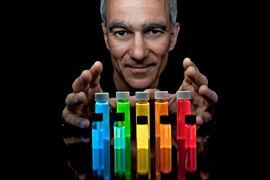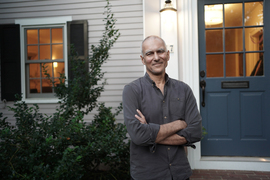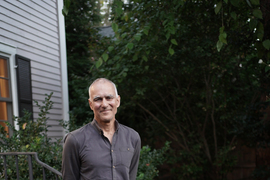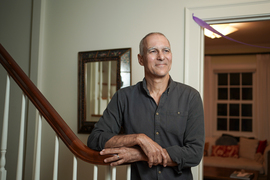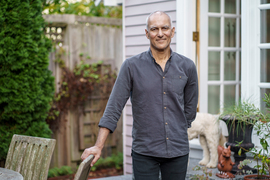Moungi Bawendi, the Lester Wolfe Professor of Chemistry at MIT and a leader in the development of tiny particles known as quantum dots, has won the Nobel Prize in Chemistry for 2023. He will share the prize with Louis Brus of Columbia University and Alexei Ekimov of Nanocrystals Technology, Inc.
The researchers were honored for their work in discovering and synthesizing quantum dots — tiny particles of matter that emit exceptionally pure light. In its announcement this morning, the Nobel Foundation cited Bawendi for work that “revolutionized the chemical production of quantum dots, resulting in almost perfect particles.”
Bawendi, who has been a professor at MIT since 1990, told MIT News this morning that he felt “surprise and shock” upon receiving the call from the Nobel committee, adding, “It was such an honor to wake up to.”
Quantum dots consist of tiny particles of semiconductor material that are so small that their properties differ from those of the bulk material. Instead, they are governed in part by the laws of quantum mechanics that describe how atoms and subatomic particles behave. When illuminated with ultraviolet light, the dots fluoresce brightly in a range of colors determined by the sizes of the particles.
These tiny particles are now used in many types of biomedical imaging, as well as computer and television displays, and they also hold potential in fields such as photocatalysis and quantum computing.
“It’s hard to think of a more elegant expression of Mind and Hand,” MIT President Sally Kornbluth wrote about Bawendi’s work, in a letter to the MIT community this morning, in reference to MIT’s motto, “Mens et Manus.” “We join Moungi’s family, his department, and his friends and colleagues around the world in celebrating this rare honor.”
Sculpting tiny particles
Quantum dots are particles only a few nanometers in diameter — about one-millionth the size of a pinhead. Since the 1930s, scientists had predicted that particles so tiny would show unusual behavior because at such tiny scales there is less space for a material’s electrons, so they become squeezed together. As a result, it was believed that the particles’ size would influence physical properties such as color.
However, this hypothesis was difficult to test because there were no ways to produce such tiny particles — until the early 1980s, when Ekimov and Brus independently succeeded at creating quantum dots. Working with quantum dots floating freely in a solution, Brus demonstrated that the size of the particles affected the color that they emitted. Ekimov discovered the same phenomenon working with nanoparticles of glass tinted with copper chloride.
The techniques used by Ekimov and Brus, however, did not yield quantum dots of uniform size. In 1993, Bawendi and his students were the first to report a method for synthesizing quantum dots while maintaining precise control over their size.
By systematically varying the conditions under which the quantum dots were crystallized, Bawendi and his research group succeeded in growing nanocrystals of a specific size. At the time, the researchers were interested in making quantum dots so they could further study their unique properties, with no inkling of what they would later become useful for.
“We just pushed and pushed, and we eventually developed a process to make particles good enough for basic science studies, and it turned out the process could be used for far more than that, which we never would have thought at the time,” Bawendi told MIT News.
Since then, he has also devised ways to control the efficiency of the dots’ light emission and to eliminate their tendency to blink on and off, making them more practical for applications in many fields.
Quantum dots are now used in flat screen TVs and other displays, where they generate more vivid images than traditional LED screens. They are also used to label molecules inside cells, allowing them to be imaged more easily, and they have been explored as a tool to guide doctors during surgery by illuminating tissue.
“It’s really great to see how they have been used in so many areas, but it’s not something we were expecting at the time,” says Bawendi, who is also a core member of the Microsystems Technology Laboratories at MIT. “We were just interested in studying the materials.”
Introducing Bawendi at an MIT press conference this morning, Kornbluth described his Nobel achievement as “a banner day” for the Institute.
“We cannot imagine anything more electrifying,” Kornbluth said. “Obviously, that excitement reflects our respect for this extraordinary honor, but it runs deeper because you'd be hard pressed to find a community with a greater reverence for the wondrous beauty of basic discovery science and the incredible power of innovation to better our world than the people of MIT. I hope this award and all of this week's science Nobels can serve to remind the nation and the world of why fundamental science deserves our sustained and enthusiastic support.”
A new field of science
Born in Paris to a French mother and Tunisian father, Bawendi moved to West Lafayette, Indiana, as a young boy when his father, a mathematician, became a professor at Purdue University. In 1982, he earned his undergraduate degree from Harvard University, where as a first-year student, he failed his first chemistry exam. That experience taught him a valuable lesson in perseverance, which he described at today’s press conference.
“You have a setback, but you can persevere and overcome this and learn from your experience, which obviously I did,” he said. “And I could have just decided this wasn't for me, but I liked what I was doing, and so I learned how to become successful as a student.”
Bawendi went on to earn a PhD from the University of Chicago in 1988. As a postdoc, he worked with Brus, who was then at AT&T Bell Laboratories and had recently made his original discovery regarding the properties of different sized quantum dots.
“That was what made me excited to work with him, because it opened up a brand new field of science, which creates a lot of opportunity to make new discoveries,” Bawendi told MIT News.
Scientists are now exploring the possibility of using quantum dots to improve the performance of many other technologies, including solar cells, flexible electronics, and photocatalysts. In recent years, Bawendi’s lab has also developed spectrometers based on quantum dots, which are small enough to fit inside a smartphone camera. Such devices could be used to diagnose diseases, especially skin conditions, or to detect environmental pollutants.
When asked at the press conference what the future might hold for quantum dot research, Bawendi said he expects to be surprised.
“That's a really good question because I'm constantly surprised when I go to conferences about the progress and the directions of the field,” he said. “I think 30 years ago, none of us who started the field could have predicted 30 years later we’d be where we are today. And it's just amazing to me, if you have really great people working on a brand new field with brand new materials, innovation comes out in directions that you can't predict.”
Being at MIT, with its focus on interdisciplinary research, has been a critical factor in his success, Bawendi told MIT News.
“The atmosphere at MIT is really what allowed me to explore other fields of science, which has been key to the advances I’ve been able to make,” he says. “It’s a unique place, and it’s wonderful to be part of it.”
